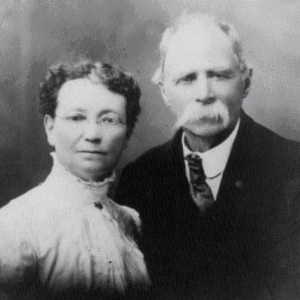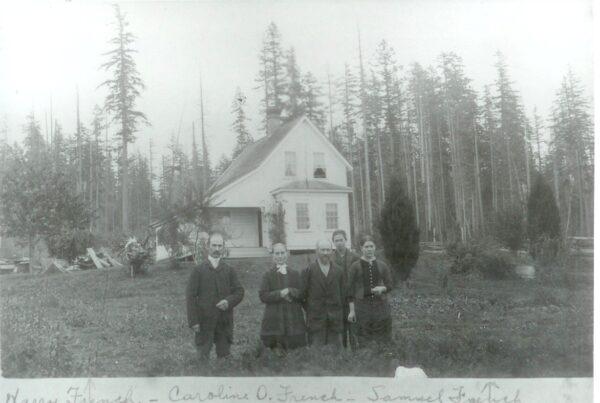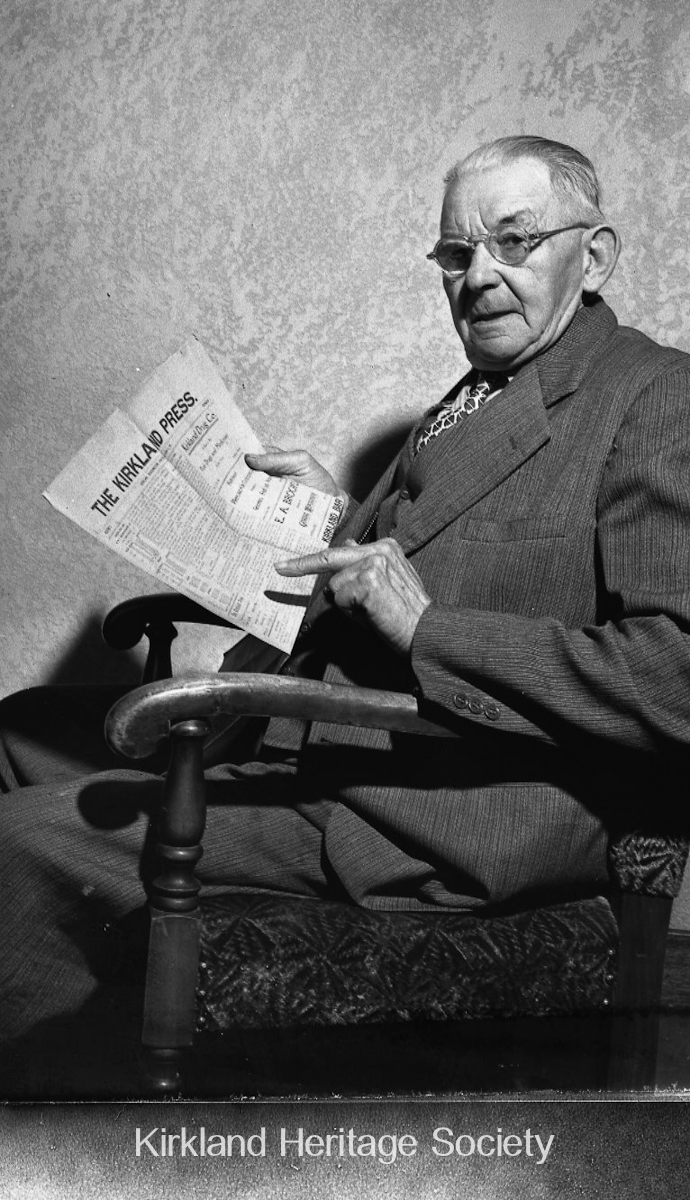By Matthew McCauley
1877: Mr & Mrs. Forbes Come to Juanita Bay
Eliza and Dorr Forbes came west from Iowa in the 1870s and settled at Juanita Bay.
The story of Juanita’s “first family” was first preserved back in the late 1930s.
Armed with a pen and the back of an envelope, the late Dorris (Forbes) Beecher sat on a porch with her grandmother, Eliza Forbes (1849-1942), and began documenting the historic Forbes saga. At that time, Eliza had been widowed for nearly two decades, but her mind was still clear and sharp. The family was a close one and Mrs Beecher’s first name was spelled ‘Dorris’ instead of the much more common ‘Doris’ to honor her late grandfather, Dorr.
Eliza and her husband Dorr Forbes (1841-1919) arrived on Seattle’s primitive waterfront in 1877 with two young sons and all their belongings. During the War Between the States, Dorr enlisted in 1861 at age 20 and served as a mounted scout and sharpshooter with the then just formed E Company of the 33rd Illinois Infantry Regiment of Volunteers—a battle-hardened unit which saw considerable action including the Siege of Vicksburg. He was wounded in action and discharged in 1863.
After the war, Dorr moved to Iowa where he became a cattle buyer and farmer. There, he met a young teacher, Eliza Ann Waggener. The two married in 1874 and were soon planning their move west. In 1876 the couple and their young son, Ray, boarded an emigrant train in Knoxville, Iowa, and rode the train for two weeks until it finally reached Sacramento, California.
The family then boarded a ship in San Francisco and traveled north Hillsborough, Oregon where they took up residence in a log cabin, where shortly thereafter a second son, Leon, was born. Eliza and the boys remained at the cabin, but Dorr made a trip north to scout the opportunities in Puget Sound country. He returned with a favorable report and the family took a boat to Kalama, Washington, then a train to Tacoma, where they boarded a Seattle-bound steamer. They stayed overnight in Seattle, then still a rough-and-tumble logging town and seaport, at the old New England Hotel.
The next day, the family hauled its possessions by horsedrawn wagon over the hill to Lake Washington at a spot then called derisively called Fleaburg— today’s Leschi—a flea-infested Native American settlement with only one permanent cabin at that time. There they loaded everything onto a steamer so tiny Eliza told Dorris years later that it “looked more like a ship’s boat.”
The steamer chugged its way north, and Eliza said her apprehension about the move melted immediately when she first laid eyes on Juanita Bay. She said there wasn’t a soul in sight, just a beautiful bay surrounded by giant trees. She said she knew at that moment that Juanita was where she wanted to live.
The family’s first homesite was near the northwest corner of the intersection of today’s NE 116th and 100th Ave. NE. They had one neighbor, Martin Hubbard, who lived nearby. At that time Juanita was often called Hubbard, but the name Juanita was soon in use instead. Their first house had already been constructed in Seattle and they had it hauled to the foot of Madison Street and then barged it across the lake and then dragged it up to its final position, which must have been quite a task. During their first year in Juanita they had a third son, Allen. The small community was soon joined later in 1877 by Charles and Mary Dunlap (1850-1908) and their four children. Charles Dunlap (1846-86) was also a Union veteran who had fought with the 4th Iowa Cavalry, I Company. Dunlap worked as a school teacher. The Forbes and Dunlap families had know each other in Iowa.
In the early 1880s, Dorr attempted to raise cranberries on additional property they homesteaded on Rose Hill at Forbes Lake. Beavers ruined his efforts, and he sold that property in 1889 to the Kirkland Land and Improvement Company and it later became the site of the Great Western Iron and Steel Works.
Eliza gave birth to their fourth son, Leslie, or “Les” as he was known, in 1886 at their first home, but soon thereafter the couple built a second home off today’s 97th Avenue NE and Dorr built a shingle mill near it on Juanita Creek. Hubbard worked there with him and the two also logged trees from Finn Hill and the surrounding area.
Neighbors were quite space and far flung—among their friends were other noted Eastside pioneers, Ole (1837-1914) and Marit Josten (1840-1913), who homesteaded 160 acres at the site of today’s Juanita High School, Bothell founders, David (1820-1905) and Mary Anne Bothell (1823-1907), and Woodinville founders Ira (1833-1906) and Susan Woodin (1848-1919). Like Dorr Forbes, both men were Union vets. Mrs Beecher said her grandmother and fellow pioneer woman Susan Woodin were good friends. Susan Woodin would walk from her homestead in today’s Woodinville, often stay overnight at the Forbes home and then the next day she would cross the lake to Seattle via rowboat or canoe, land at the foot of Madison Street, and then walk the three miles to downtown Seattle to sell butter, then walk back to the lake, cross, stay at the Forbes place and then walk back home. Susan Woodin also served as Woodinville’s postmistress.
Eliza said during her early years she was frightened one day when a group Indians showed up at her door. They were just transitory group, though, and all they wanted was to warm their feet by the stove inside.
A staunch Republican, on January 23, 1887 she was the first woman elected justice of the peace on the west coast.
In Washington Territory women could vote before was possible in most of the rest of country. When Washington became a state in 1889, women lost that right Eliza had to step down from office. She remained a political activist and had a large photograph of Teddy Roosevelt prominently displayed in her living room. She frequently attended Republican party meetings in Seattle. Mrs Beecher recalled that once when Eliza was in her late 80s she made the trip across the lake to one party function and fell and broke her arm. Undaunted, she returned home and her daughter-in-law, Alicia Forbes, called Dr George Davis who attempted to splint the broken arm. Eliza stubbornly refused to wear the splint and despite that her arm healed perfectly.
In her later years, typically Forbes family member would transport Eliza, but if a family member was not available, she didn’t let that stop her. She would call the jitney (taxi) in Kirkland to come pick her up and take her to the ferry so she could attend Republican party meetings. Once she was in her 90s, her sons asked the jitney operators to no longer fetch her when she called. Undaunted, one time she disappeared and the family made a mad search for her. They heard from a neighbor that he’d seen her: she was out alongside the road hitching a ride to the ferry. Seemingly, Eliza Forbes did what Eliza Forbes wanted to do!
Another time, again in her later years, Eliza disappeared for the day, but returned very excited. As a young woman in the 1800s she’d had a dream one night that she was flying through the sky in a machine that carried passengers through the sky—a dream years prior to the advent of powered flight. Eliza had slipped over to Seattle and flew in an airplane to Bremerton and back. She said the experience was her dream coming true. At the time of her adventure, few Kirkland-area residents and certainly no other member of the Forbes family had flow in an airplane. This feisty pioneer grandma was the first.
King County owned the 1905 Forbes house from 1956 until 2002, when the City of Kirkland acquired Juanita Beach Park. The family extensively remodeled it in 1937, so its appearance has changed since 1905, but it still stands at 11829 97th Ave. NE. Mrs. Beecher said her grandparents planted the fruit trees around their home, some of which still growing in the yard.
Mrs Beecher said even well into her senior years, her pioneer grandmother would still catch fish from Juanita Creek, then a thriving salmon stream but also home to trout and other edible species, and liked to pick stinging nettles, dandelions and wild berries as part of her meals. Mrs Beecher said Eliza also enjoyed sitting on porch and shooting robins from her fruit trees with a .22 rifle. Pioneers considered robin’s breast a culinary delicacy and she continued to live as a rugged, individualistic pioneer, right up to her death in 1942.
What Eliza and Dorr Forbes saw from the old New England Hotel their night in Seattle during 1877. This c. 1875 view taken from the hotel looks up First Avenue from South Main Street. Seattle was then still a rough-and-tumble western lumber town and seaport. The hill was called “Denny’s Knoll” and has been softened somewhat through regrading since that time. The highest building, with the cupola, was the old Territorial University, earliest incarnation of the UW, which did not move to its present Portage Bay location until 1895. The Territorial University also offered primary grade subjects. Though the structure dates to 1861, it was not until 1876 that it had its first graduate, Clara McCarty. She went on to a teaching career and in 1879 was elected Pierce County’s superintendent of schools. (Info compiled from several Historylink.org essays, a veritable treasure trove of additional information on early Seattle and Washington history generally–highly recommended!).
Dorr and Eliza built this house, seen c. 1880s, their second at Juanita, off today’s 97th Avenue NE. It burned in 1905, but the couple immediately rebuilt a new home on the same property.
In addition to his shingle mill, Dorr Forbes was a logger. He had a contract to cut cordwood, used to fuel the early Lake Washington steamboats’ boilers.
View looking south at Lake Washington c. 1913 down today’s 97th Avenue NE, then called Bothell Road. The Forbes home was on the right, at their mailbox.
Susan Woodin, Woodinville co-founder, was a good friend of Eliza Forbes’.




